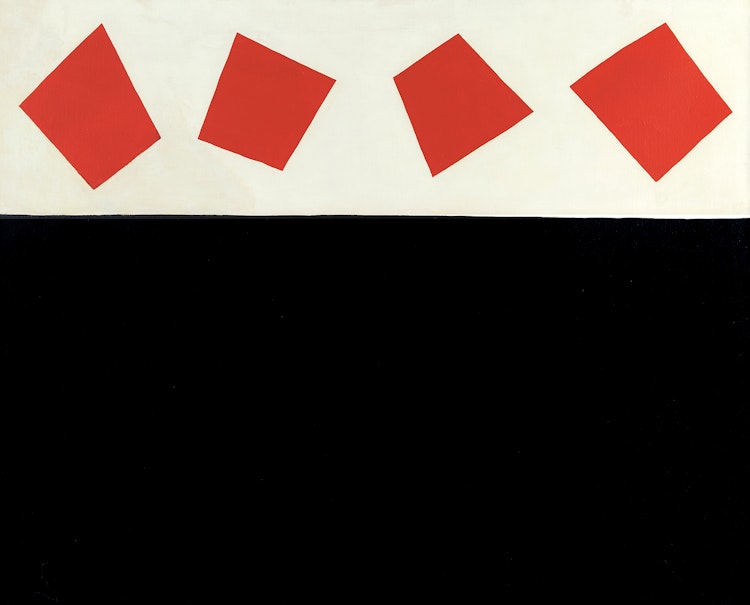Le rouge et le noir by Christian Marcel Barbeau

Marcel Barbeau
Le rouge et le noir
oil on canvas
signed, titled and dated 1963 on a label on the stretcher
32 x 39.5 ins ( 81.3 x 100.3 cms )
Auction Estimate: $14,000.00 - $18,000.00
Price Realized $11,500.00
Sale date: May 25th 2017
Private Collection, Ottawa
Ann Davis, Marcel Barbeau: Works from 1957-1989, Kaspar Gallery, Toronto, 1989, unpaginated
Moving away from the all-over abstraction favoured by his Automatiste predecessors, careful control has been employed in the form of the shape and compositional arrangement. The lower portion of the composition is heavy and calm with the solid black form wrapping around the edges of the canvas which balances the more sporadic and energetic red rectangles dancing at the upper edge of the frame. The viewer bears witness to a subtle tension between dimensions combining both freedom and intellect. There is the liberty of the artist to create, but an important cognizant measure to the process, replacing the fervent gesture of the artist with control.
Share this item with your friends
Christian Marcel Barbeau
(1925 - 2016) Les Automatistes, RCA
Born in Montreal in 1925, Marcel Barbeau was a student of Paul-Émile Borduas at the École de meuble in 1944. Initially enrolled in the École de meuble as a carpentry student who, admittedly, knew nothing about art noticed a rambunctious class run by Borduas. Curious, Barbeau received permission to transfer into this class. Barbeau and Borduas developed an intense relationship as a teacher and mentor. Barbeau signed Borduas’ famous manifesto Refus global but did not receive the same consequences at Borduas as he, at the time, was jobless and did not have a family. The pair remained close until Borduas immigrated to the United States. Barbeau studied alongside Jean Paul Riopelle at the École de meuble.
As early as 1946, Barbeau participated in Automatistes exhibitions. “Veillomonde” (1949) was exhibited in the second Automatistes exhibition that was held in Pierre and Claude Gauvreau’s apartment. Early in his career, Barbeau experimented with many different ways to make paintings. For example, in “Sauvage-Furie ou Automne-delire” (1947) he used a palette knife to peel back the surface of the painting. In “Au Château d’Argol” (1946-47) Barbeau overlaid linear black lines on top of clusters of red and turquoise. In 1947, Barbeau made fifty “all over” paintings. His “all over” paintings were inspired by European surrealism and Barbeau produced works where lines seemingly floated across the canvas. In 1950, he painted three hundred and fifty coloured ink drawings called Combustions originelles.
Throughout his life Barbeau often moved to different cities to experience various art communities. In the 1960s and 1970s he lived in Europe and the United States, in Paris, California, and New York. In doing this Barbeau was able to gain first-hand experience in current aesthetic developments in the art world. He would bring skills he found useful back to his studio in Montreal and incorporate various techniques into his personal repertoire. Due to his extensive travels and knowledge of the modern art world, Barbeau was able to have a conversation of sorts in his paintings with fellow artists, such as Jackson Pollock, Robert Motherwell, and Ellsworth Kelly. Movement was important for Barbeau and he composes his work in a de-centred way that makes it slightly off balance. Perhaps, his fascination with movement is derived from his interest in dance. Barbeau first became interested in dance in 1947 when he made a mask for a piece choreographed by Françoise Sullivan, a fellow contributor to Refus global.
Literature Source:
Robert Enright, “Marcel Barbeau: The Colour of Change.” Border Crossings, Issue 114 (May 2010)
We extend our thanks to Danie Klein, York University graduate student in art history, for writing and contributing this artist biography.

